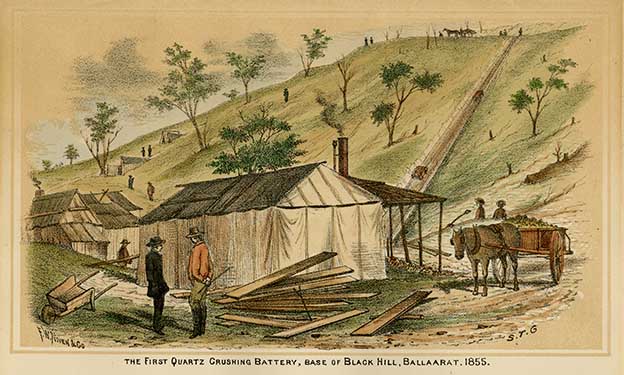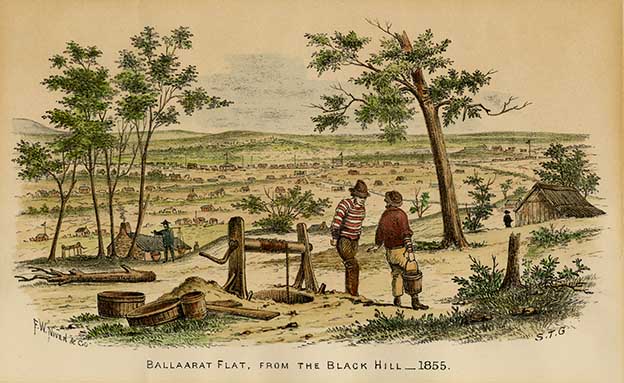Black Hill
Contents
Background
On the morning of 03 December 1854 the government forces crossed Yarrowee Creek at Black Hill. The exact point is unknown due to mining activity of the years. From the top of Black Hill to the north one of the diggers on duty saw the Military and Police and fired a single warning shot.</ref>
The order to fall in and be silent was given, and when Captain Thomas had spoken a few words we were put in motion, led by Captain Wise. The party had not advanced three hundred yards before we were seen by the rebel sentry who fired, not at our party, but to warn his party in the Stockade. he was on Black Hill.[1]
In a letter written by Dr George Wakefield to his father dated 01 May 1856 he described:
- I am living at the foot of an immense mountain called the Black Hill which is composed of quartz reefs containing immense quantities of gold. It seems to be the origin of the gold leads in this district as they commence from it. The amount of gold taken by some parties is scarcely credible .... The population too would astonish a few, here we have representatives of all the nations of the face of the globe not the least wonderful of which is the aboriginal nation. I have frequently been present at their corroborees, and their skill in throwing the spear, boomerang etc., is wonderful. I saw the boomerang thrown yesterday. It went completely out of sight & in about 6 (seconds) descended at the feet of the thrower ... (Bowden 1977: 92) [2]
Lookout 1854
- THE MILITARY POINT OF VIEW
- A long letter, dated February 7, 1870, and signed "John Neill, late of the 40th Regiment," describing the attack on the Stockade, and some of the immediately subsequent events gives the point of view of a soldier who took part in them.
- "As a military man," he writes, "and one who took a most prominent part in all the military movements of that day, I beg leave to offer a remark upon the statement made by the Government officer of the camp. The small force consisted of detachments of the 12th and 40th Regiments, and a few troopers and foot police, the whole under the command of Captains Thomas and Wise, and a lieutenant of the 12th — I forget his name. The order to fall in and be silent was given, and when Captain Thomas had spoken a few words we were put in motion, led by Captain Wise. The party had not advanced three hundred yards before we were seen by the rebel sentry, who fired, not at our party, but to warn his party in the Stockade. He was on Black Hill. Captain Thomas turned his head in the direction of the shot and said:—
- "We are seen. Forward, and steady, men! Don't fire; let the insurgents fire first. You wait for the sound of the bugle.'
- "When within a short distance of the Stockade the insurgents fired. Captain Wise fell, mortally wounded. The same volley wounded the lieutenant of the. 12th. already spoken of, and three of his men; two killed, one wounded of the 40th—Privates Michael Roney, Joseph Wall, killed; William Juniper, badly wounded The camp officer says the police were the first to enter the Stockade. He is wrong. There was not one policeman killed or wounded during the whole affair. When Captain Wise fell the men cheered, and were over in the Stockade in a second, and then bayonet and pike went to work. The diggers fought well and fierce, not a word spoke on either side until all was over. The blacksmith who made the pikes was killed by Lieut. Richards, 40th Regiment. Honor to his name; he fought well and died gloriously. It was rumored that at that time the police were cruel to the wounded and prisoners. No such thing. The police did nothing but their duty, and they did it well for men who were not accustomed to scenes of blood or violence- To my knowledge there was only one wounded man despatched, and he kept swinging his pike about his head as he sat on the ground. His two legs were broken, and he had a musket ball in his bcdy. He could not live, and it was best to despatch him. His name was O'Neill, a native of Kilkenny, Ireland. I heard this statement from a sergeant of police, and I knew it was correct."[3]
Eureka Lookout 1854
- THE MILITARY POINT OF VIEW
- A long letter, dated February 7, 1870, and signed "John Neill, late of the 40th Regiment," describing the attack on the Stockade, and some of the immediately subsequent events gives the point of view of a soldier who took part in them.
- "As a military man," he writes, "and one who took a most prominent part in all the military movements of that day, I beg leave to offer a remark upon the statement made by the Government officer of the camp. The small force consisted of detachments of the 12th and 40th Regiments, and a few troopers and foot police, the whole under the command of Captains Thomas and Wise, and a lieutenant of the 12th — I forget his name. The order to fall in and be silent was given, and when Captain Thomas had spoken a few words we were put in motion, led by Captain Wise. The party had not advanced three hundred yards before we were seen by the rebel sentry, who fired, not at our party, but to warn his party in the Stockade. He was on Black Hill. Captain Thomas turned his head in the direction of the shot and said:—
- "We are seen. Forward, and steady, men! Don't fire; let the insurgents fire first. You wait for the sound of the bugle.' ... [4]
Names associated with Living in Black Hill
Also See
References
- ↑ Letter from John Neill, 40th Regiment dated 7 February 1870
- ↑ Ian D. Clark, Another Side of Eureka - the Aboriginal presence on the Ballarat goldfields in 1854- Were Aboriginal people involved in the Eureka Rebellion?, University of Ballarat, 2007.
- ↑ THe World's News, 06 August 1930.
- ↑ The World's News, 06 August 1930.
Further Reading
Victorian Places, https://www.victorianplaces.com.au/black-hill
Victorian Places, https://www.victorianplaces.com.au/node/68367
Victorian Places, https://www.victorianplaces.com.au/node/68368


